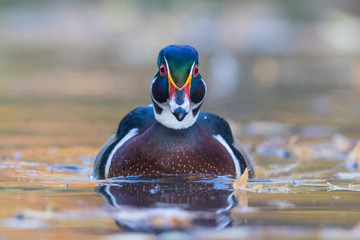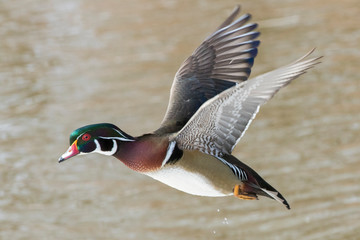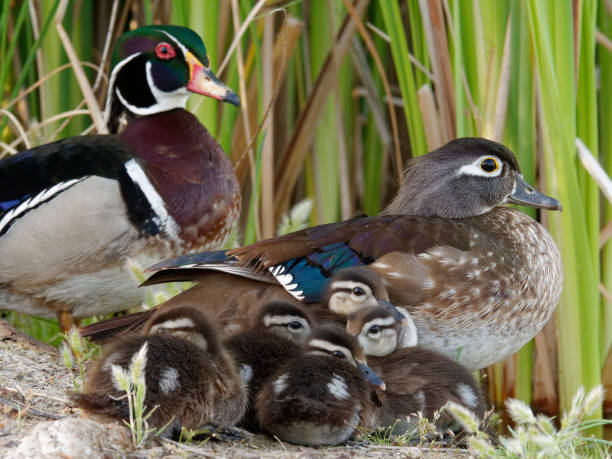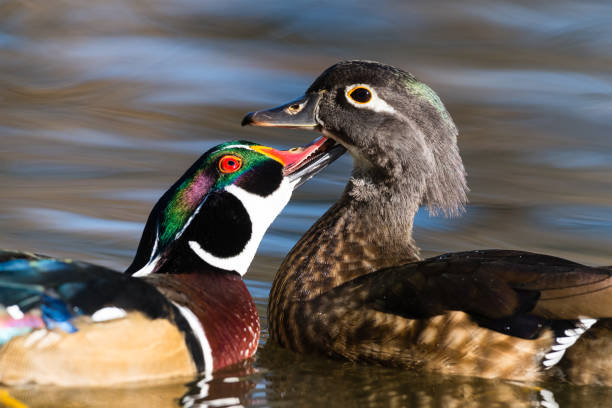Table of Contents
- Description
- Distribution
- Habitat
- Diet
- Behavior
- Lifespan
- Reproduction and Lifecycle
- Predators
- Adaptations
- Conservation Status
Scientific Classification
| Kingdom | Animalia |
| Phylum | Chordata |
| Class | Aves |
| Order | Anseriformes |
| Family | Anatidae |
| Genus | Aix |
| Species | Aix sponsa |
| Scientific Name | Aix sponsa |
1. Description
The Wood Duck is among the most visually stunning waterfowl found in North America. Males display vibrant iridescent shades of green, blue, and purple, complemented by distinctive white markings and a striking red eye. In contrast, females are characterized by a unique white eye-ring and a mottled brown body, which provides excellent camouflage. These medium-sized ducks typically measure between 18 to 21 inches in length and have a wingspan ranging from 26 to 29 inches. Unlike most ducks, their feet are adapted for perching, allowing them to easily climb trees.

2. Distribution
Wood Ducks are native to North America, with their range extending from southern Canada, throughout much of the United States, and into parts of Mexico. They are particularly plentiful in the eastern United States and along the Pacific coast. During winter, northern populations migrate south in search of warmer climates, while southern populations often remain in their habitats year-round.
3. Habitat
Wood Ducks are typically found in forested wetlands, swamps, rivers, ponds, and lakes. They favor locations rich in vegetation and trees, which makes them unique among North American waterfowl that often prefer more open environments. These ducks commonly nest in tree cavities near water sources. They thrive in partially shaded, slow-moving freshwater, unlike many other duck species that tend to favor open water.

4. Diet
Wood Ducks are omnivores with a diverse diet that consists of:
Plant matter: Seeds, acorns, aquatic plants, and berries.
Insects: Beetles, caterpillars, and dragonflies.
Small aquatic animals: Snails, crustaceans, and small fish.
Their dietary habits shift with the seasons. During winter, they tend to consume more plant-based foods, while in spring and summer, they prioritize protein-rich animal sources.
5. Behavior
Wood Ducks are recognized for their agility and adaptability. Unlike many other ducks, they can perch in trees thanks to their sharp claws. They are strong fliers and can swiftly navigate through dense forests. Males perform intricate courtship displays, which include head-bobbing and various vocalizations, to entice females. While they tend to be shy around humans, they are quite social with one another. Outside of the breeding season, you can often see them in small flocks.

6. Lifespan
In their natural habitat, Wood Ducks typically have a lifespan of 3 to 5 years. Nevertheless, there are instances where some individuals have reached up to 15 years. The highest mortality rates occur among ducklings, primarily due to predation and various environmental threats.
7. Reproduction and Lifecycle
Breeding season typically runs from March to June, varying by location. Wood Ducks prefer to nest in tree cavities near water sources. They will also utilize artificial nest boxes if available. The female lays between 6 to 16 eggs, which she incubates for about 28 to 32 days. After hatching, the ducklings leave the nest within 24 hours, often jumping from significant heights to reach the ground or water. Despite their seemingly fragile appearance, they are quite resilient and can survive falls from over 50 feet without injury. The mother then leads her young to the water, where they begin to learn how to fend for themselves, feeding on small aquatic creatures and plants.

8. Predators
Wood Ducks encounter a variety of predators, such as:
Egg and nestling predators: Raccoons, snakes, and squirrels.
Duckling predators: Large fish, snapping turtles, herons, and birds of prey.
Adult predators: Foxes, bobcats, hawks, and owls.
Their remarkable flying abilities and quick take-off from the water enable them to evade dangers both in the air and on land.
9. Adaptations
- Wood Ducks have several impressive adaptations:
- Webbed feet with sharp claws: This unique feature enables them to perch in trees, which is uncommon for ducks.
- Keen eyesight: Crucial for moving through their densely wooded environments.
- Camouflaged plumage: Particularly in females, allowing them to blend in perfectly with their surroundings while nesting.
- High egg production: This trait helps to counterbalance the high predation rates on their eggs and ducklings.
10. Conservation Status
Wood Ducks experienced significant declines in their populations during the late 1800s and early 1900s due to habitat destruction and excessive hunting. Thanks to various conservation initiatives, their numbers have rebounded. These efforts include the establishment of nest box programs, habitat preservation, and regulations on hunting. Currently, the IUCN categorizes them as Least Concern. Nevertheless, continued conservation work is essential to ensure their populations remain robust.
The Wood Duck is a striking and adaptable bird found in forested wetlands across North America. Its recovery from the brink of extinction underscores the critical role of conservation. By safeguarding its habitat, we can ensure that the Wood Duck continues to be a beloved part of North America’s diverse avian community.




